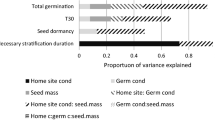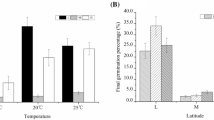Abstract
The germination response of 20 species from high altitude Mediterranean climates, most of them rare endemics, was studied. Our main goal was to model the germination response of a complete set of Iberian high mountain species. The effect of temperature and other parameters, such as spatial and temporal short gradients, on germination were also evaluated. Some seed features (mass and size) were also related to the germination response. Finally, we tested the effect of cold-wet stratification pretreatment when germination was low under natural conditions. Seeds were collected at four locations from 1,900 to 2,400 m a.s.l. in the Sierra de Guadarrama (Spanish Central Range) over two consecutive growing seasons (2001–2002) and submitted to different temperatures and a constant photoperiod of 16 h light/8 h darkness. Most plants readily germinate without treatment, reaching an optimum at relatively high temperatures in contrast to lowland Mediterranean species. Seeds seem to be physiologically prepared for rapid germination even though these plants usually face very intense summer droughts after ripening and dispersal. Germination was also highly variable among altitudes, populations and years, but results were inconsistent among species. Such flexibility could be interpreted as an efficient survival strategy for species growing under unpredictable environments, such as the Mediterranean climate. Finally cold-wet stratification increased germination capacity in five of nine dormant species, as widely reported for many arctic, boreal and alpine species. In conclusion, high mountain Mediterranean species do not differ from alpine species except that a relatively high number of species are ready to germinate without any treatment.





Similar content being viewed by others
References
Acharya SN (1989) Germination response of two alpine grasses from the Rocky Mountains of Alberta. Can J Plant Sci 69:1165–1177
Amen RD (1965) Seed dormancy in the alpine rush, Luzula spicata L. Ecology 46:361–364
Amen RD (1966) The extent and role of seed dormancy in alpine plants. Q Rev Biol 41:271–281
Angosto T, Matilla AJ (1994) Modifications in seeds of Festuca indigesta from two different altitudinal habitats. Seed Sci Technol 22:319–328
Baskin CC, Baskin JM (1998) Seed ecology, biogeography, and evolution of dormancy and germination. Academic, San Diego
Bell KL, Bliss LC (1980) Plant reproduction in high arctic environment. Arctic Alpine Res 12:1–10
Bell DT, Plummer JA, Taylor SK (1993) Seed germination ecology in southwestern Australia. Bot Rev 59:24–73
Bewley JD, Black M (1982) Physiology and biochemistry of seeds Viability, dormancy, and environmental control, vol 2. Springer, Berlin Heidelberg New York
Billings WD, Mooney HA (1968) The ecology of arctic and alpine plants. Biol Rev 43:481–529
Bliss LC (1971) Arctic and alpine plant life cycles. Annu Rev Ecol Syst 2:405–438
Bonner FT (1990) Storage of seeds, potential and limitations for germplasm conservation. For Ecol Manage 35:35–43
Brown RA, Johnston RS (1979) Revegetation of disturbed alpine rangelands. In: Johnson DA (ed) Special management needs of alpine ecosystem Range Science Series No 5. Society for Range Management, Denver, Colo., pp 78–94
Callaway RM, Brooker RW, Choler P, Kikvidze Z., Lortie CJ, Michalet R, Paolini L, Pugnaire FI, Newingham B, Aschehoug ET, Armas C, Kikodze D, Cook BJ (2002) Positive interactions among alpine plants increase with stress. Nature 417:844–848
Cavieres LA, Arroyo MTK (2000) Seed germination response to cold stratification period and thermal regime in Phacelia secunda (Hydrophyllaceae). Plant Ecol 149:1–8
Cerabolini B, De Andreis R, Ceriani RM, Pierce S, Raimondi B (2004) Seed germination and conservation of endangered species from the Italian Alps, Physoplexis comosa and Primula glaulescens. Biol Conserv 117:351–356
Chambers JC (1989) Seed viability of alpine species, variability within and among years. J Range Manage 42:304–308
Chambers JC (1997) Restoring alpine ecosystem in the Western United States, environmental constrains, disturbance characteristics, and restoration success. In: Urbanska KM et al (eds) Restoration ecology and sustainable development. Cambridge University Press, Cambridge, pp 161–187
Chambers JC, McMahon JA, Brown RW (1987) Germination characteristics of alpine grasses and forbs, a comparison of early and late serial dominants with reclamation potential. Reclam Reveg Res 6:235–249
Escudero A, Carnes LF, Pérez-García F (1997) Seed germination of gypsophytes and gypsovags in semi-arid central Spain. J Arid Environ 36:487–497
Escudero A, Giménez-Benavides L, Iriondo JM, Rubio A (2005) Soil amelioration under vegetated patches in a high mountain Mediterranean community. Arct Antarct Alp Res (in press)
European Community (1992) Council Directive 92/43/EEC on the conservation of natural habitats and of wild fauna and flora
Gavilán RG, Fernández-González F, Rivas-Martínez S (2001) Variaciones bioclimáticas en Madrid: un estudio sobre cambio climático local. In: Gómez F, Mota JF (eds) Vegetación y cambos climáticos. Servicio de publicaciones de la Universidad de Almería, Almería, pp 243–256
Gavilán RG, Sánchez-Mata D, Escudero A, Rubio A (2002) Spatial structure and interactions in Mediterranean high mountain vegetation (Sistema Central, Spain). Isr J Plant Sci 50:217–228
Gómez-Campo C (1987) Libro rojo de las especies vegetales amenazadas de España peninsular e Islas Baleares. ICONA, Madrid
Grabherr G, Gottfried M, Pauli H (1994) Climate effects on mountain plants. Nature 369:448
Guisan A, Zimmermann NE (2000) Predictive habitat distribution models in ecology. Ecol Model 135:147–186
Guisan A, Edwards TC Jr, Hastie T (2002) Generalized linear and generalized additive models in studies of species distributions: setting the scene. Ecol Model 157:89–100
Gutterman Y (1994) Strategies of seed dispersal and germination in plants inhabiting deserts. Bot Rev 60:373–425
Hendry GA, Grime JP (1993) Methods in comparative plant ecology. Chapman and Hall, London
Holm SO (1994) Reproductive patterns of Betula pendula and B. pubescens coll. along a regional altitudinal gradient in northern Sweden. Ecography 17:60–72
Kigel J (1995) Seed germination in arid and semiarid regions. In: Kigel J, Galili G (eds) Seed development and germination. Marcel Dekker, New York, pp 645–699
Körner C (1999) Alpine plant life. Springer, Berlin Heidelberg New York
Marchand PJ, Roach DA (1980) Reproductive strategies of pioneering alpine species, seed production, dispersal, and germination. Arct Alp Res 12:137–146
MathSoft (1999) S-Plus 2000. Guide to statistics, vol I. Seattle, Washington
McCullagh P, Nelder JA (1989) Generalized linear models. Chapman and Hall, New York
McDonough WT (1969) Effective treatments for the induction of germination in mountain rangeland species. Northwest Sci 43:18–22
McDonough WT (1970) Germination of 21 species collected from a high-elevation rangeland in Utah. Am Midl Nat 84:551–554
Milberg P, Andersson L (1998) Does cold stratification level out differences in seed germinability between populations. Plant Ecol 134:225–234
Mooney HA, Billings WD (1961) Comparative physiological ecology of arctic and alpine populations of Oxyria digyna. Ecol Monogr 31:1–29
Palacios D, de Andrés N, Luengo E (2003) Distribution and effectiveness of nivation in Mediterranean mountain, Peñalara (Spain). Geomorphology 54:157–178
Peñuelas J, Filella I, Comas P (2002) Changed plant and animal life cycles from 1952 to 2000 in the Mediterranean region. Global Change Biol 8:531–544
Pelton J (1956) A study of seed dormancy in eighteen species of high altitude Colorado plants. Butler Univ Bot Stud 18:74–84
Pérez-García F, Iriondo JM, González-Benito ME, Carnes LF, Tapia J, Prieto C, Plaza R, Pérez C (1995) Germination studies in endemic plant species of the Iberian Peninsula. Isr J Plant Sci 43:239–247
Pyke DA, Thompson JN (1986) Statistical analysis of survival and removal rate experiments. Ecology 67:240–245
Rivas-Martínez S (1963) Estudio de la vegetación y flora de las Sierras de Guadarrama y Gredos. An Inst Bot Cavanill 21:5–330
Rivas-Martínez S, Cantó P, Fernández-González F, Molina JA, Pizarro JM, Puente E (1999) Sinopsis of the Sierra de Guadarrama vegetation. Itinera Geobot 13:189–260
Sánchez-Herrera F (2000) La restauración ambiental de la Antigua estación de esquí de Valcotos y el programa de conservación del Parque Natural de Peñalara. In: Segundas Jornadas Científicas del Parque Natural de Peñalara y del Valle del Paular. Dirección General del Medio Natural, Madrid, pp 19–25
Sanz-Elorza M, Dana ED, González A, Sobrino E (2003) Changes in the high-mountain vegetation of the Central Iberian Peninsula as a probable sign of global warming. Ann Bot 92:273–280
Schemske DW, Husband BC, Ruckelshaus CG, Goodwillie C, Parker IM, Bishop JG (1994) Evaluating approaches to the conservation of rare and endangered plants. Ecology 75:584–606
Schütz W, Milberg P (1997) Seed dormancy in Carex canescens, regional differences and ecological consequences. Oikos 78:420–428
Schütz W, Rave G (1999) The effect of cold stratification and light on the seed germination of temperate sedges (Carex) from various habitats and implications for regenerative strategies. Plant Ecol 144:215–230
Schwienbacher E, Erschbamer B (2002) Longevity of seeds in a glacier foreland of the Central Alps—a burial experiment. Bull Geobot Inst ETH Zurich 68:63–71
Spector P (1994) An introduction to S and S-PLUS. Duxbury, Belmont
Thanos CA, Kadis CC, Skarou F (1995) Ecophysiology of germination in the aromatic plants thyme, savory and oregano (Labiatae). Seed Sci Res 5:161–170
Thompson PA, Smith RD, Dickie JB, Sanderson RH, Probert RJ (1981) Collection and regeneration of populations of wild plants from seed. Biol Conserv 20:229–245
Thompson K, Band SR, Hodgson JG (1993) Seed size and shape predict persistence in soil. Funct Ecol 7:236–241
Urbanska KM (1986) Behaviour of alpine plants and high altitude revegetation research. In:Schuster MA, Buck RH (eds) Proceedings of the high altitude revegetation workshop no 7. Forth Collins, Colo., pp 215–226
Urbanska KM, Schütz M (1986) Reproduction by seed in alpine plants and revegetation research above timberline. Bot Helvet 96:43–60
Urbanska KM, Schwank O, Fossati A (1979) Variation within Lotus corniculatus L. s. l. from Switzerland, II. Reproductive behaviour of L. alpinus (DC) Schleicher. Berlin Geobot Inst ETH 46:62–85
Väre H, Lampinen C, Humphries C, Williams P (2003) Taxonomic diversity of vascular plants in the European alpine areas. In: Nagy L et al (eds) Alpine biodiversity in Europe. Ecological studies, vol 167. Springer, Berlin Heidelberg New York, pp 133–148
Venables WN, Ripley BD (1998) Modern applied statistics with S-PLUS. Springer, Berlin Heidelberg New York
Vera ML (1997) Effect of altitude and seed size on germination and seedling survival of heathland plants in north Spain. Plant Ecol 133:101–106
Zuur-Isler D (1982) Germinating behaviour and early life phase of some species from alpine serpentine soils. Berlin Geobot Inst ETH 49:76–107
Acknowledgements
We would like to thank graduate students María Gómez and Silvia González for assistance in the laboratory. Arantzazu López de Luzuriaga reviewed an earlier draft of the manuscript. This research was financed by the Spanish Ministry of Science and Technology (Project REN 2003-03366).
Author information
Authors and Affiliations
Corresponding author
About this article
Cite this article
Giménez-Benavides, L., Escudero, A. & Pérez-García, F. Seed germination of high mountain Mediterranean species: altitudinal, interpopulation and interannual variability. Ecol Res 20, 433–444 (2005). https://doi.org/10.1007/s11284-005-0059-4
Received:
Accepted:
Published:
Issue Date:
DOI: https://doi.org/10.1007/s11284-005-0059-4




